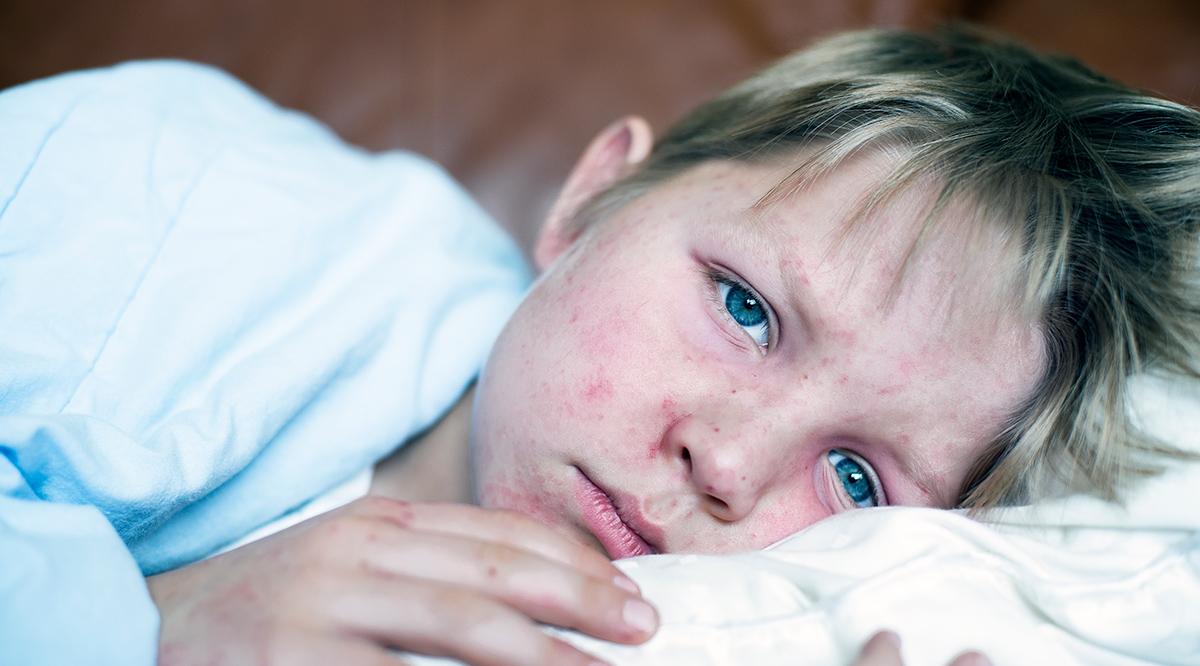As the United States faces its largest measles outbreak in years, parents and doctors alike are having to educate themselves about the virus, which was declared eliminated in the country 25 years ago.
“I’ve been doing this for 20 years, and up until 2019, I had never seen [a case of] measles,” says Aaron Milstone, MD, MHS, a pediatric infectious disease specialist at Johns Hopkins Children’s Center and a professor of pediatrics at the Johns Hopkins University School of Medicine in Baltimore.
The last outbreak, in 2019, occurred in communities with low vaccination rates in New York City; that year, the country had a total of 1,274 reported cases, according to data from the Centers for Disease Control and Prevention (CDC). As of April 24, 2025, there have already been 884 reported cases and three deaths this year, mostly tied to an outbreak in West Texas among unvaccinated individuals.
“We’re on track to eclipse [the 2019 outbreak,] for sure,” says Milstone, noting that the official numbers are likely underestimates, since many people don’t report mild cases. This outbreak is also more widespread, with cases reported in more than half of U.S. states.
“We need to be prepared, as more and more states are reporting cases,” says Scott Roberts, MD, associate medical director of infection prevention at Yale New Haven Health and an assistant professor at the Yale School of Medicine. “It does need to be on clinicians’ radars.”
While most people in the United States are protected from the virus through vaccination or previous infection, measles is one of the most contagious viruses in existence, so health care providers should familiarize themselves with the symptoms, and hospital leaders should have a plan for handling a local outbreak, Milstone says.
Before the measles vaccine was introduced in 1963, each year, approximately 3 million to 4 million people in the United States were infected, 400 to 500 died, 48,000 were hospitalized, and 1,000 were diagnosed with encephalitis, a swelling of the brain that can cause serious complications, including brain damage, hearing loss, intellectual disabilities, and death.
Still, despite the measles vaccine being 97% effective at preventing infection, increasing vaccine hesitancy and misinformation about vaccine safety have resulted in a decline in parents getting their children vaccinated. This has opened up the opportunity for outbreaks.
AAMCNews interviewed infectious disease experts from academic medical centers to help answer common questions about the measles virus, the vaccine, and how health care providers can help prevent another epidemic.
How does measles spread, and what are the symptoms?
Measles is one of the most contagious viruses in existence and will infect 9 out of 10 people who come into contact with an infected person if those not yet infected don’t already have immunity, according to the CDC. It spreads through airborne particles from an infected person’s cough or sneeze. These particles can linger in a poorly ventilated indoor space for up to two hours after the person has left the room.
Public health infection control protocols are similar to those implemented during the COVID-19 pandemic, including encouraging handwashing, wearing masks, disinfecting high-touch surfaces, and requiring people who test positive for the virus to stay home and avoid others who don’t have prior immunity or are immunocompromised.
All U.S. states and the District of Columbia require measles vaccination for children attending school, but exemptions to the mandates have been inching up in recent years.
Measles symptoms generally appear seven to 14 days after contact with the virus and can initially include fever, cough, runny nose, diarrhea, vomiting, and watery eyes. After two to three days of symptoms, tiny white spots might appear inside the mouth, and after three to five days, the telltale measles rash (flat red spots) begins to appear, starting on the face and spreading down the body. A person with measles can be contagious for up to four days before and four days after the rash appears.
“From a health care worker perspective, the problem with measles is severalfold,” Roberts says. “The disease mimics other things. A patient may present with fever and runny nose, but the rash comes on later. I have three kids in preschool, and my kids meet those criteria every day. It’s tough” to catch measles early.
Measles can have rare, but serious complications, including blindness, pneumonia, encephalitis, and death.
What should I do if I think I or my child might have measles? Are there any treatments?
People exhibiting measles symptoms and planning to seek medical help should call ahead to their doctor’s office or hospital to inform them of a possible measles case before arriving, Milstone says.
He emphasizes that this is essential because pediatrician offices and hospital emergency departments are often visited by people who are particularly vulnerable to the severe complications of measles. These include newborns and babies who are too young to be vaccinated, unvaccinated pregnant women and their unborn babies, and immunocompromised people.
Roberts says that, additionally, putting a mask on the sick person can also help prevent spreading the infection.
“One thing we’ve learned [from the COVID-19 pandemic] is that masking can reduce risk of transmission of almost any pathogen.”
While there is no approved treatment for measles, doctors can offer some help with symptom relief. The World Health Organization recommends fluids to help with dehydration from diarrhea and vomiting, antibiotics to treat pneumonia and ear infections that arise due to the virus, and vitamin A supplements to help prevent blindness.
The American Academy of Pediatrics (AAP), however, warns that claims that vitamin A can prevent measles are false.
“Vitamin A is recommended for children diagnosed with measles to help prevent complications, particularly in children who are hospitalized,” said Sean T. O’Leary, MD, MPH, chair of the AAP Committee on Infectious Diseases in a press release on Feb. 27, 2025. “It should not be used to try to prevent measles, and high doses of vitamin A are potentially very harmful. The only effective way to prevent measles is the MMR [measles, mumps, and rubella] vaccine.”
Who should be vaccinated? Should I get a booster?
The MMR vaccine, which is administered in two doses to children, one at 12 to 15 months old and another at 4 to 6 years old, is 97% effective at preventing infection. A single dose of the vaccine is 93% effective against infection. According to the CDC, a community must have 95% immunity from either the vaccine or prior infection to prevent an outbreak. Gaines County, the epicenter of the West Texas outbreak, had a vaccination rate of 82% among kindergartners last year, state records show.
Unlike with COVID-19 and the flu, the measles virus does not mutate enough to require additional vaccinations, so most people who have been vaccinated or who have had a prior infection will have robust immunity for life, Roberts explains. This also means people who were born before 1957 and never got vaccinated (the vaccine became available in 1963) are still protected, because experts believe all people born in that period were infected at some point and have natural immunity.
Any eligible child or adult who is unvaccinated or does not have documentation of their vaccination or a confirmed prior infection should speak with their health care provider about getting the shot.
Adults who were vaccinated between 1963 and 1967 should also speak with their health care provider about a blood test for immunity or a vaccine, since early vaccines were not as effective as those available today. The CDC says there’s no harm in getting an additional vaccine if immune status is unknown.
Babies can receive a first dose of the vaccine as early as 6 months old if they live in an area with an active outbreak or will be traveling internationally, according to the CDC.
Before 1989, most children received only one dose of the vaccine, so anyone in that group who is in a high-risk situation, such as health care workers, might consider getting a second dose for additional protection, Roberts adds.
However, since the vaccine does include a live virus, the CDC recommends against vaccination for people who have weakened immune systems — for example, those on immunosuppressant drugs for organ transplants, and pregnant women.
The CDC also says that unvaccinated people with a known exposure should seek care immediately. They can receive either a dose of the MMR vaccine within 72 hours of exposure or an infusion of antibodies within six days, though not both, to help prevent serious disease.
What can health care providers do?
In the United States, 91% of children age 2 and older had gotten one dose of the MMR vaccine as of 2021, according to CDC data, and as of the 2023-2024 school year, 93% of kindergartners had been vaccinated.
But these numbers may not provide an accurate picture, since they don’t include all children under age 5 for the past four years.
That’s why Eric G. Zhou, PhD, an instructor of pediatrics, cardiology, and population health science and policy at the Icahn School of Medicine at Mount Sinai in New York City, and a team of researchers have used digital health surveys to gather information on measles vaccination trends.
One study, published in March 2025, which asked 20,000 parents of children under 5 about their children’s measles vaccination status, found that the vaccination rate for this age group could be as low as 71% — lower than CDC statistics suggest and below the 95% needed for herd immunity.
Though the study had limitations, including self-reporting bias and the fact that some parents may have reported vaccination status for babies not yet eligible for the vaccine, it raises concerns that more young children could be susceptible to measles than national data suggests, Zhou says.
“The general U.S population experienced a tremendous disruption from the COVID-19 pandemic in seeking care,” he says. “We see this evolving parental hesitancy, which shows the importance of establishing trust and transparency in developing vaccines and using data and evidence to alleviate some of these concerns.”
Physicians may have a significant role in assuaging people’s doubts regarding vaccines. Some studies have shown that patients with doubts about a vaccine are more likely to accept it if their physician recommends it directly and assertively. The AAP offers guidance for pediatricians on how to effectively reassure parents regarding vaccination.
Additionally, targeting public health outreach to communities with low vaccination rates could help.
One study found that, during the 2019 measles outbreak in several communities in New York City, vaccination promotion in these areas increased the vaccination rate from 80% to 91%.
But with proposed budget cuts to national health care agencies, Milstone worries public health efforts could be stymied, putting even more responsibility on leaders in academic medicine to speak up.
“The public health outreach is going to be critical,” he says. “Academic health centers should play an active role in public health messaging.”


